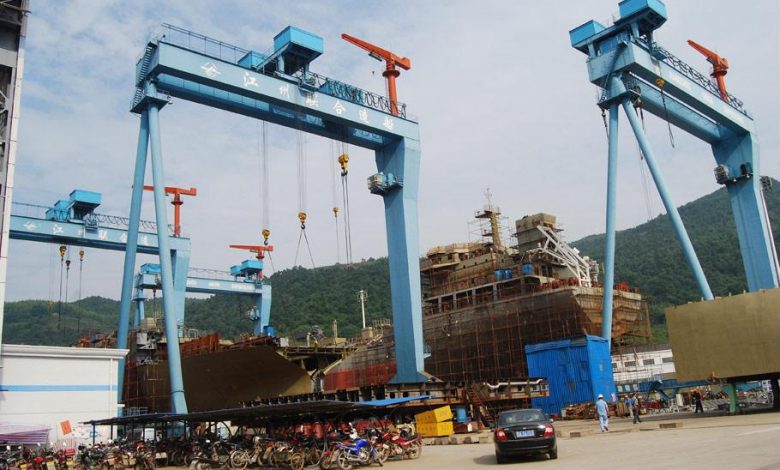China’s decision to reopen mothballed yards: the big picture

Panos Patsadas from Target Maritime Transport fears the People’s Republic new found capabilities to package finance and yard slots together will bring more woe to traditional shipowners.
Shipping has reacted with concern about yesterday’s lead story on Splash that China is reopening shuttered yards. But let’s take a step back and look at the big picture for a moment.
While the comments made about yards not having been completely shut, or yards being prematurely opened without proper infrastructure are valid, I feel the issue of overcapacity should not be the main concern at this point in time. It will still take two to three years for a newbuild vessel to hit the water, and in this respect, provided scrapping continues at the pace of 2017-2018, the effects of overcapacity should not put a strain on the market recovery; not in the short term at least.
One should always consider that, what may look like overcapacity in the global orderbook now, will only have a physical effect on supply in two to three years’ time.
What I personally find more alarming for the market however is yards being reopened, at the same time as China making an aggressive debut into ship financing.
The long-term vision of China towards self-sufficiency in marine transport is not a secret and something in the making for about 15 years now. What is new is China entering the ship finance market, a market traditionally controlled in Europe, the US and Japan.
The problem emerging is two-fold in my eyes. On one hand, subsidised Chinese shipyards that failed to survive in a depressed market are given a lifeline at the expense of healthy yards. Although Japanese and Korean yards will be put under strain, they do have a steady clientele of third and fourth generation traditional shipowners, who always return and will not hesitate to pay a premium for superior quality newbuilds. What about non-traditional owners though, like investors, financial institutions? That’s when I start having a feeling of déjà vu.
We are presently, for the dry market at least, at the early stage of a recovery, and the same is also reflected in the recent S&P and newbuild activity. If you are a traditional owner, you know where to go. If you are not a traditional owner, but a new entrant, and you are looking for a ‘quick hop on the train’ before it’s too late, where do you go? That’s where I feel the Chinese have spotted a market gap. With most European banks being very conservative in providing shipping finance, and an equity/debt ratio of 50/50 considered a good deal these days, anyone with an alternative offering is likely to draw investors. More so, when the financing package comes with a proposed list of ‘resurrected’ yards who can see ambitious projects through. It is here where the real danger lies. If one considers the finance and the shipyard being offered as a ‘package’, it immediately gives an entry to non-traditional players in shipping. What should normally be the privilege of seasoned, knowledgeable market players with a track record, is bundled as a product, and readily available to anyone willing to invest and looking for an easy entry.
Of course, the subsidies and reopening of yards raises concerns over fair competition, and of course the quality of ships coming out of these yards can be a separate debate in itself. But making shipping a product has historically proved to be far more dangerous than both unfair competition or substandard ships together. I do think the lesson we should take from 2008 was that the market collapsed from a lack of understanding of how shipping works, and not from lack of money.

Good analysis.
Sounds like China is looking for potential ship buyers to whom European banks not lend money. Either the European banks are too conservative and are missing good lending opportunities or the Chinese will be picking up bad ones. Whatever entity is set up to finance ship construction will find somebody to take the money on offer. Or maybe this is simply a make-work project and China is not too concerned about eventual repayment. Hmmmm.
If it’s driven by China’s dream of being the single largest ship financier ( not new by the way, it was a stated objective as far back as 2008, at Marine Money Singapore) or just to create employment, salary and thereby domestic economic demand growth is arbitrary, the end result will be another cycle of surplus tonnage that will inevitably in two or three years time contribute to another boom/ bust episode.
If China reenter ship financing as well as reopen mothballed yards then in five years they will have the ironic honor of being the largest ship CONstruction Country as well as the largest ship finance REStructuring Country. Good luck with that. When will the shipowner ever learn? Why do we always believe we are the ONLY one who can recognize an up cycle.As the antivory trade says “ When the buying stops so will the killing”
One might wonder what other countries will be tempted (or can afford to) copy the Chinese model, whilst being painfully cognisant of those who inspired it.
We cannot expect the owners to stop being the eternal optimists. That is in the nature of the business, its saving grace and also its Achilles Heel. The question is who else will start having aspirations about becoming an owner or shipping investor. With cheap finance and a package entry…..I think plenty will show up for the party.
I agree. This is part of the eternal dance of shipowning; the wise old owners come out of the business and enthusiastic new ones enter it and very often, having failed to read history, repeat the same mistakes. The handful of long term family businesses go on for ever.